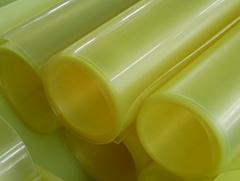Centrifugal Molding Method and Polyurethane Sheet (board) Material

This method is used to manufacture thin and complex shaped products. It can also be laminated, covered and composited to manufacture reinforced materials, such as lining cloth, fibers and steel wires in the mold to manufacture reinforced sheets, pipes and various teeth. Shaped transmission belt and so on. This method is to inject the liquid mixture into the center of the mold and make it flow into the mold cavity by centrifugal force. The liquid mixture does not need to degas.
Centrifugal force can produce forced deaeration. The rotation speed varies with different materials and products, generally 500-2000r/min is appropriate. Maintain a balance between rotation rate, viscosity and gel rate, otherwise, the product is prone to unevenness.
The difference between plate and sheet is the difference in thickness and external dimensions. Polyurethane sheet (plate) material processing generally adopts compression molding, non-compression molding and centrifugal molding. The thickness of centrifugal molding is generally about 10mm. For plate (sheets) below 10mm, if high precision, uniform hardness and large area are required, centrifugal molding is generally used. Thick plates are formed by moulding.
The above-mentioned molding and centrifugal molding methods obviously limit the size of the (sheet) plate to be produced, and other methods of plate (sheet) production have been developed subsequently. For example, a belt cutter is used to peel off a cylindrical colloid into pieces. This method is mainly suitable for products with a thickness of 1 to 3 mm. If the PU cylinder produced has no bubbles, the peeling sheet can be used to produce a long and good quality polyurethane sheet.










